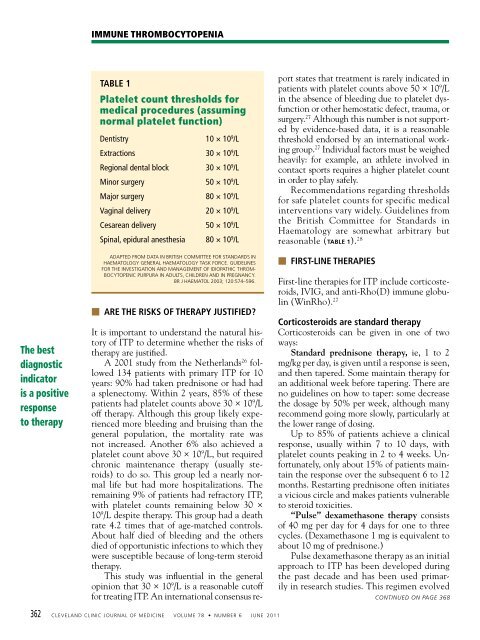Immune thrombocytopenia: No longer 'idiopathic'
Immune thrombocytopenia: No longer 'idiopathic'
Immune thrombocytopenia: No longer 'idiopathic'
You also want an ePaper? Increase the reach of your titles
YUMPU automatically turns print PDFs into web optimized ePapers that Google loves.
The best<br />
diagnostic<br />
indicator<br />
is a positive<br />
response<br />
to therapy<br />
IMMUNE THROMBOCYTOPENIA<br />
TABLE 1<br />
Platelet count thresholds for<br />
medical procedures (assuming<br />
normal platelet function)<br />
Dentistry 10 × 10 9 /L<br />
Extractions 30 × 10 9 /L<br />
Regional dental block 30 × 10 9 /L<br />
Minor surgery 50 × 10 9 /L<br />
Major surgery 80 × 10 9 /L<br />
Vaginal delivery 20 × 10 9 /L<br />
Cesarean delivery 50 × 10 9 /L<br />
Spinal, epidural anesthesia 80 × 10 9 /L<br />
ADAPTED FROM DATA IN BRITIsh COMMITTEE FOR sTANDARDs IN<br />
hAEMATOLOgy gENERAL hAEMATOLOgy TAsk FORCE. gUIDELINEs<br />
FOR ThE INVEsTIgATION AND MANAgEMENT OF IDIOPAThIC ThROM-<br />
BOCyTOPENIC PURPURA IN ADULTs, ChILDREN AND IN PREgNANCy.<br />
BR J hAEMATOL 2003; 120:574–596.<br />
■ ARE THE RISKS OF THERAPY JUSTIFIED?<br />
It is important to understand the natural history<br />
of ITP to determine whether the risks of<br />
therapy are justified.<br />
A 2001 study from the Netherlands 26 followed<br />
134 patients with primary ITP for 10<br />
years: 90% had taken prednisone or had had<br />
a splenectomy. Within 2 years, 85% of these<br />
patients had platelet counts above 30 × 10 9 /L<br />
off therapy. Although this group likely experienced<br />
more bleeding and bruising than the<br />
general population, the mortality rate was<br />
not increased. Another 6% also achieved a<br />
platelet count above 30 × 10 9 /L, but required<br />
chronic maintenance therapy (usually steroids)<br />
to do so. This group led a nearly normal<br />
life but had more hospitalizations. The<br />
remaining 9% of patients had refractory ITP,<br />
with platelet counts remaining below 30 ×<br />
10 9 /L despite therapy. This group had a death<br />
rate 4.2 times that of age-matched controls.<br />
About half died of bleeding and the others<br />
died of opportunistic infections to which they<br />
were susceptible because of long-term steroid<br />
therapy.<br />
This study was influential in the general<br />
opinion that 30 × 10 9 /L is a reasonable cutoff<br />
for treating ITP. An international consensus re-<br />
362 CLEVELAND CLINIC JOURNAL OF MEDICINE VOLUME 78 • NUMBER 6 JUNE 2011<br />
port states that treatment is rarely indicated in<br />
patients with platelet counts above 50 × 10 9 /L<br />
in the absence of bleeding due to platelet dysfunction<br />
or other hemostatic defect, trauma, or<br />
surgery. 27 Although this number is not supported<br />
by evidence-based data, it is a reasonable<br />
threshold endorsed by an international working<br />
group. 27 Individual factors must be weighed<br />
heavily: for example, an athlete involved in<br />
contact sports requires a higher platelet count<br />
in order to play safely.<br />
Recommendations regarding thresholds<br />
for safe platelet counts for specific medical<br />
interventions vary widely. Guidelines from<br />
the British Committee for Standards in<br />
Haematology are somewhat arbitrary but<br />
reasonable (TABLE 1). 28<br />
■ FIRST-LINE THERAPIES<br />
First-line therapies for ITP include corticosteroids,<br />
IVIG, and anti-Rho(D) immune globulin<br />
(WinRho). 27<br />
Corticosteroids are standard therapy<br />
Corticosteroids can be given in one of two<br />
ways:<br />
Standard prednisone therapy, ie, 1 to 2<br />
mg/kg per day, is given until a response is seen,<br />
and then tapered. Some maintain therapy for<br />
an additional week before tapering. There are<br />
no guidelines on how to taper: some decrease<br />
the dosage by 50% per week, although many<br />
recommend going more slowly, particularly at<br />
the lower range of dosing.<br />
Up to 85% of patients achieve a clinical<br />
response, usually within 7 to 10 days, with<br />
platelet counts peaking in 2 to 4 weeks. Unfortunately,<br />
only about 15% of patients maintain<br />
the response over the subsequent 6 to 12<br />
months. Restarting prednisone often initiates<br />
a vicious circle and makes patients vulnerable<br />
to steroid toxicities.<br />
“Pulse” dexamethasone therapy consists<br />
of 40 mg per day for 4 days for one to three<br />
cycles. (Dexamethasone 1 mg is equivalent to<br />
about 10 mg of prednisone.)<br />
Pulse dexamethasone therapy as an initial<br />
approach to ITP has been developed during<br />
the past decade and has been used primarily<br />
in research studies. This regimen evolved<br />
CONTINUED ON PAGE 368
















